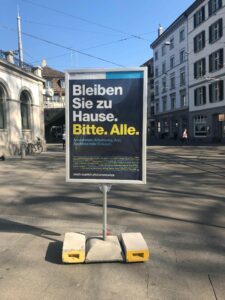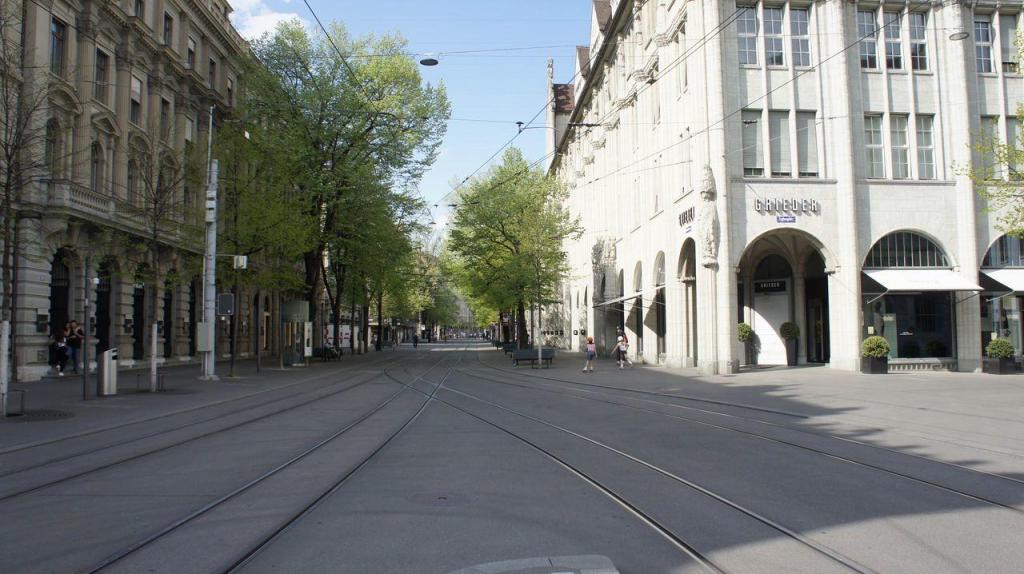Steps to Freedom: City sidewalks during and after COVID-19
Monika Litscher presents some field observations and thoughts related to sidewalks, public space and mobility in Swiss cities during the current pandemic as lessons to learn for a sustainable urban way of life.
Rose is waiting in front of the bakery, patiently standing in line at the yellow marks on the sidewalk that are helping people to keep the regulation two meters distance. It is Saturday morning, the ambience in her neighbourhood of Zurich is relaxed, in spite of the pandemic.
Keeping distance and avoiding each other on the sidewalks has become a part of her new daily routine. Despite the grave scenarios there was, fortunately, no catastrophic course and no total collapse of the health system in Switzerland. Her salary appeared on time in her bank account while she diligently worked at home. When it came to her turn in the shop, the baker’s wife knows exactly what Rose wants, small talk, still carefully keeping distance and back on the sidewalk. All the walking, to free her mind, to keep her body healthy or to run essential errands, sometimes also for her elderly neighbour, taking a break on the little wall of the small green space every now and then, and the waiting in front of the grocery store, or on Sundays in front of the ice cream wagon, allows Rose to discover a new social dimension of the sidewalk in her neighbourhood.

A Covid-19 promenade in Zurich
We have known for a long time about the qualities of walking for mental and physical health and walking is a basic human need. During the pandemic different effects showed: The precious experience of simple movement on foot; the importance of personal perception on an equal footing. Sidewalks offer such a contact zone and space of social solidarity directly in front of the home. This is also crucial to regain trust and connect with communities, and somehow in a small structured neighbourhood even possible with restricted outward oriented activities of the ground floors.
Old and newly discovered social dimensions of sidewalks
Sidewalks are the central nervous system of every city and the essentials of urban public space, guaranteeing or preventing quality of life and vitality (Litscher 2015: pp186-198). One of the first advocates of sidewalks in the beginning of the 1800s, Arthur Dillon, was planning this infrastructure for people and he was quite aware of its social potential and progress for urban development. He advertised wide sidewalks with a specific meaning as commercial and social space, which lead to urban comfort, besides the need of security and insufficient hygiene for pedestrians, namely all citizens including children and elderly persons (Lampugnani 2019: pp161).
This was long before the motorisation of the masses and the monofunctional car-centric design of cities. Take a glance at our cities now: the entangled relations between mobility, planning, spatial and economic development, urban design, infrastructure, social and health policies, the wellbeing of society and individuals and now the ecological destruction are still relevant. The system with all the co-creating public, private and civilian actors is even more complex. During this experience of the pandemic, its strengths of space for people on foot, and the need of a purpose driven collaboration and interdisciplinary handling, are becoming even more obvious.
Where has all the liberating potential of sidewalks gone?
As nearly forgotten ‘public stages’ (with reference to the theatre metaphor of Erving Goffman), especially in densely inhabited neighborhoods of cities, sidewalks are supposed to offer free and democratic space for everybody to perform publicly in their own way, to experience everyday diversity, to interact socially or to cultivate small, creative and clandestine businesses. Let’s think about all the iconic scenes in movies like John Travolta walking down the street in Staying Alive (1983). Aspects of such images and possibilities of appropriation of sidewalks were rediscovered in cities around the globe during the current pandemic, mainly due to the reduced radius of people’s mobility.

Instructions for public space
Still true: expanded streets are producing traffic
During lockdown motorised vehicles were, at least for a time, forced out of the public space. With that dwindling number, the danger, fatalities, pollution, disease and destruction associated with vehicles fell. Although the benefits of the new situation for walking in urban spaces are so obvious, I am afraid that the change of mobility patterns will prove to be temporary. Based on the observations in Switzerland, I cannot agree with all the hopeful voices, unless we make real changes after this.
A look at the streets of Beijing, highly congested with cars and sinking in smog after lockdown demonstrates this clearly. Just because of this pandemic, we will not automatically adjust our way of life. It could be said that China has a very different situation to Europe, but in Switzerland even during the peak of the pandemic in March and April 2020 no redistribution of city street space in favour of walking or cycling happened at all. On the contrary, cars are coming back now with the easing of the restrictions, and they do so speedily and in large numbers.
No change of mobility without a cultural transformation
Instead of a temporary opening of streets for pedestrians or cyclists, Swiss cities have closed down parks, including their footpaths and cycle lanes without compensation. This kind of action and cutting back was accompanied with arguments that it was too crowded, that too many people would come, and that they should stay at home.
The silence of the politicians was striking (to be fair, now at the end of the strict recommendations, a handful of politicians are softly claiming more room, particularly for cyclists, rarely for pedestrians, rather for garden cafés). Such action or passivity does not give any hope for an imminent cultural transformation. The lack of safety for people was obviously not enough to make the case for safe street space. The number of progressive mindsets desiring a sustainable city with satisfactory public spaces for human beings is still too small.
Discrimination on sidewalks
To tell another story about experiences on the sidewalk during the pandemic, let’s focus on everyday struggles and social isolation of vulnerable people. Instead of meeting with friends and walking around the city, vulnerable groups were being told to stay at home for their own health and for the security of the care system. A lot of these people barely dare to leave their homes, even if they know a short walk would be essential to avoid physical pain and depression. Being outside on the footpath, quickly, only to buy a few essentials, is now accompanied by a nagging conscience, the feeling of discrimination and each evasive manoeuvre due to the lack of width brings the danger of being exposed to the deadly virus.
Distancing impossible
Even under normal circumstances, the minimum width of a sidewalk of 1.5 meters and the norm of 2 meters leads to crowding. During the pandemic, a safe distant crossing has often been impossible. Who has easiest access to public space and who has safe space not only reveals existing inequalities and poor structures, but also in case of urban mobility shows the disadvantages and low prestige of pedestrians. It also shows a concrete everyday experience of exclusion (and as a car driver, mostly alone in the vehicle, an experience of privilege and inclusion).
Sidewalks and consumerism
The business districts of inner cities including the pedestrian zones are empty at the moment, the sidewalks and streets of more inhabited neighbourhoods however were dynamic and busy. It becomes obvious which kind of infrastructure does serve the common good and how a human-centred city looks. Without the office workers, tourists and consumers, the empty parking lots, closed shops, the whole design, structure and use of our inner cities seems meaningless. Such exclusively commercialised infrastructures are non-places (with reference to Marc Augé). They are neither social nor do they care about people, community or equality.
This crisis is shifting consumerism towards the Internet. All the goods ordered online have to be delivered. All the packing material has to be disposed of. The tangible unloading and waste disposal zone is the sidewalk, the public space between motorised vehicles and buildings. It serves as a traditionally established interface of moving and standing, of rolling traffic, walking and resting, of public and private, and now penetrating, of online and offline within the quite loose legal frames.
Habituated behaviour
The systematic training of the habits of pedestrians started with the popular education and its narratives nearly one hundred years ago. Back then, sidewalks were built in Switzerland not for the comfort of pedestrians, but to make sure that the motorised traffic can speed without any human obstacles. The needs of pedestrians and quality of life in cities that come along with human beings and social interactions were not discussed. Instead, the experts focused on road safety with a car-centric view. The internalisation of the subordinate role of pedestrians was instructed repeatedly by various popular road safety training and education guides (Via Storia 2014: 8-11). Until now, even during the pandemic, the norm of human behaviour in city streets is still strongly regulated by traffic rules, accompanied by different habits and imaginations about what is a real city or what conception of human beings and urban community prevails.
Conclusion
These few illustrations show that a sustainable change of our mobility, which is an important part of the quality of life in a city, has to be seen as a broad cultural process. May we learn from the experiences during this pandemic and re-evaluate urban mobility. Such a transformation is only going to go smoothly if structures, technology and practices play together successfully. A walkable, sustainable and equitable city, which is affordable for people, fruitful for creativity and prosperity, needs the investment of private, public and civilian actors. Let’s contribute, step-by-step forward towards a new urban lifestyle. Are you in?
Author: Monika Litscher Urban Researcher, Social and cultural Anthropologist, Managing Director of the Swiss Pedestrian Association www.fussverkehr.ch mlitscher@bluemail.ch
References:
Lampugnani, Vittorio Magnago (2019). Bedeutsame Belanglosigkeiten. Kleine Dinge im Stadtraum. Berlin: Wagenbach.
Litscher, Monika (2015). Urbane Szenerien. Ein Konzept im Repräsentationsmodus der ethnografischen Collage in Bild und Text. Internationale Hochschulschriften. Münster: Waxmann.
ViaStoria, ASTRA [Hg.] (2014). Geschichte des Langsamverkehrs in der Schweiz des 19. und 20. Jahrhunderts. Eine Übersicht über das Wissen und die Forschungslücken. (Materialien Langsamverkehr Nr. 130).
